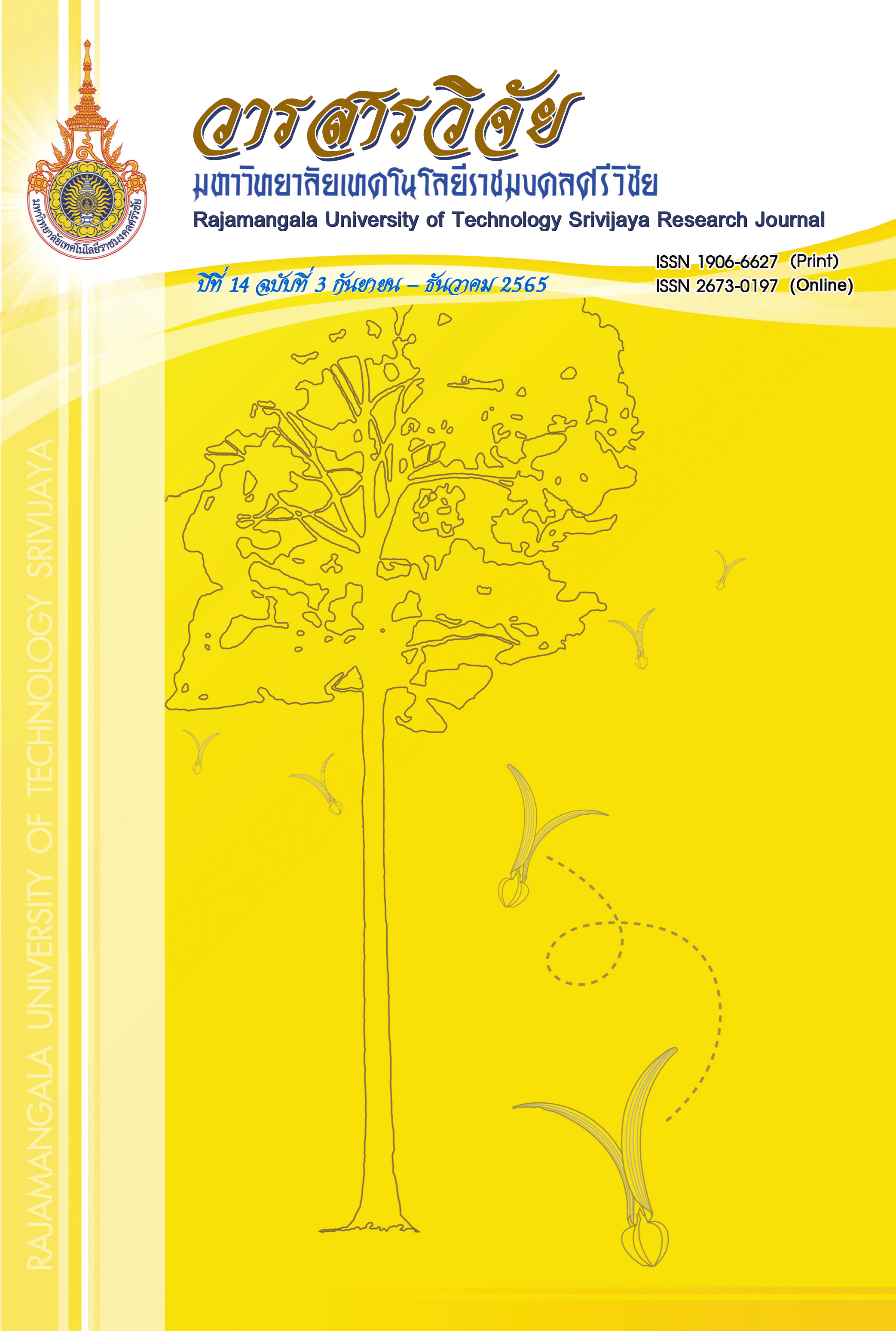Extraction Methods on Quality of Ya-Nang Juice (Tiliacora triandra)
Keywords:
Yanang, extraction methods, antioxidant, blanchingAbstract
The objective of this research is to study the extraction methods that affect physiochemical properties and antioxidant activities by DPPH radical scavenging activity of Yanang juice (Tiliacora triandra) for 4 treatments: (1) fresh Yanang leaves were extracted with water at 1:2 (w/w) ratio and at speed 1 for 5 min (control); (2) fresh Yanang leaves were blanched at 100°C for 2 minutes and were blended with water at 1:2 (w/w) ratio and at speed 1 for 5 min; (3) fresh Yanang leaves were blended with water at 1:3 (w/w) ratio and at speed 1 for 5 min and were boiled at 100°C for 10 minutes and (4) fresh Yanang leaves were blanched at 100°C for 2 minutes, extracted with water at 1:3 (w/w) ratio and at speed 1 for 5 min and then boiled at 100°C for 10 minutes. Chlorophyll a, b, total carotene and beta-carotene were 261.64 to 478.58 µg/100 gfw, 27.06 to 102.36 µg/100 gfw, 45,655.27 to 62,610.61 µg/100 gfw and 29.64 to 40.86 mg/100 gfw, respectively. The L* a* and b* values were 28.27 to 29.58, -0.32 to -2.45 and 3.65 to 5.66, respectively. It is concluded that the optimal method of extraction of Yanang juice is treatment 4 because the sample concentration that can inhibit 50% of DPPH radicals (IC50) was the lowest in comparison with standard BHT and Trolox, and had the highest total phenolic content of 1.27 mg/ml and 3,668.05 mg GAE/100 g sample, respectively.
References
AOAC. 1990. Official methods of analysis. 15th Ed. Association of Official Agricultural Chemists, Washington DC.
Chaikham, P., Chunthanom, P. and Apichartsrangkoon, A. 2013. Storage stability of pennywort juice as affected by high pressure and thermal processing. International Food Research Journal 20(6): 3069-3076.
Chaikham, P., Worametrachanon, S. and Apichartsrangkoon, A. 2014. Effects of high pressure and thermal processing on phytochemical, color and microbiological qualities of herbal-plant infusion. International Food Research Journal 21(1): 51-57.
Dere, ş., Güne, ş.T. and Sivaci, R. 1998. Spectrophotometric determination of chlorophyll-a, b and total carotenoid contents of some algae species using different solvents. Turkish Journal of botany 22: 13-17.
Gross, J. 1991. Pigments in Vegetables. Van Nostrand Reinhold, New York.
Imeh, U. and Khokhar, S. 2002. Distribution of conjugated and free phenols in fruits: Antioxidant activity and cultivar variations. Journal of Agricultural and Food Chemistry 50: 6301.
Kubola, J. and Siriamornpun, S. 2008. Phenolic contents and antioxidant activities of bitter gourd (Momordica charantia L.) leaf, stem and fruit fraction extracts in vitro. Food Chemistry 110: 881-890.
Li, B.B., Smith, B. and Hossain, Md.M. 2006. Extraction of phenolics from citrus peels I. Solvent extraction method. Separation and Purification Technology 48: 182-188.
Mahidol, C., Sahakitpichan, P. and Ruchirawat, S. 1994. Bioactive natural products from Thai plants. Journal of Pure and Applied Chemistry 66: 2353-2356.
Murkovic, M., Mülleder, U. and Neunteufl, H. 2002. Carotenoid Content in Different Varieties of Pumpkins. Journal of Food Composition and Analysis 15(6): 633-638.
Naibaho, N.M., Laohankunjit, N. and Kerdchoechuen, O. 2012. Physico-chemical properties of plant extracts from Yanang (Tiliacora triandra) leaves. Agricultural Science Journal 43(2): 533-536.
Phomkaivon, N. and Areekul, V. 2009. Screening for antioxidant activity in selected Thai wild plants. Asian Journal of Food and Agro-Industry 2(4): 433-440.
Sakanaka, S., Tachibana, Y. and Okada, Y. 2005. Preparation and antioxidant properties of extracts of Japanese persimmon leaf tea (kakinoha-cha). Food Chemistry 89: 569-575.
Sapers, G.M. 1993. Browning of foods: control by sulfites antioxidants, and other means. Food Technology 47(1): 75-84.
Singthong, J., Ningsanond, S. and Cui, S.W. 2009. Extraction and physicochemical characterisation of polysaccharide gum from Yanang (Tiliacora triandra) leaves. Food Chemistry 114: 1301-1307.
Sireeratawong, S., Lertprasertsuke, N., Srisawat, U., Thuppia, A., Ngamjariyawat, A., Suwanlikhid, N. and Jaijoy, K. 2008. Acute and subchronic toxicity study of the water extract from Tiliacora triandra (Colebr.) Diels in rats. Songklanakarin Journal of Science and Technology 30(5): 611-619.
Sriket, P. 2014. Chemical components and antioxidant activities of Thai local vegetables. KMITL Science and Technology Journal Part B 14(1): 18-24.
Downloads
Published
How to Cite
Issue
Section
License
Copyright (c) 2022 Rajamangala University of Technology Srivijaya Research Journal

This work is licensed under a Creative Commons Attribution-NonCommercial-NoDerivatives 4.0 International License.
The content and information in the article published in Journal of Rajamangala University of Technology Srivijaya It is the opinion and responsibility of the author of the article. The editorial journals do not need to agree. Or share any responsibility.







